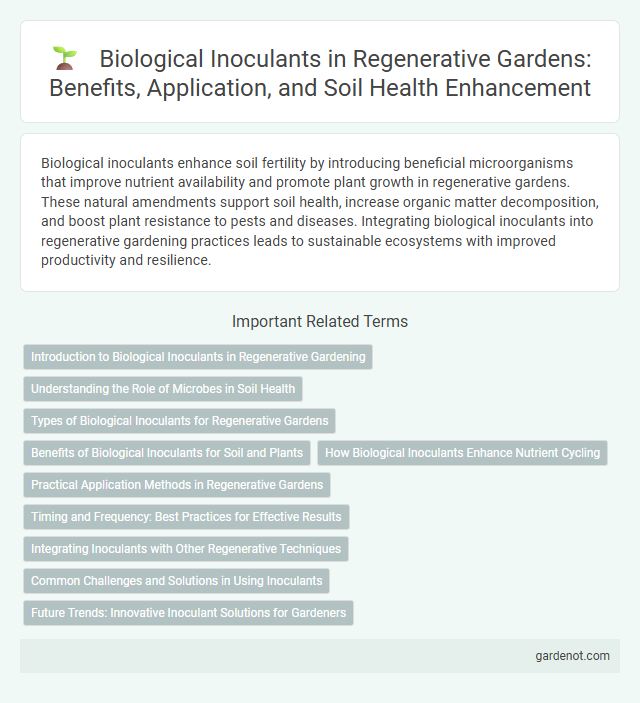Biological inoculants enhance soil fertility by introducing beneficial microorganisms that improve nutrient availability and promote plant growth in regenerative gardens. These natural amendments support soil health, increase organic matter decomposition, and boost plant resistance to pests and diseases. Integrating biological inoculants into regenerative gardening practices leads to sustainable ecosystems with improved productivity and resilience.
Introduction to Biological Inoculants in Regenerative Gardening
Biological inoculants in regenerative gardening are natural soil amendments containing beneficial microorganisms such as bacteria, fungi, and mycorrhizae that enhance nutrient cycling and improve plant health. These inoculants promote symbiotic relationships with plant roots, increasing nutrient uptake, soil biodiversity, and resilience against pests and diseases. Incorporating biological inoculants supports sustainable soil regeneration and boosts overall garden productivity without relying on synthetic chemicals.
Understanding the Role of Microbes in Soil Health
Biological inoculants introduce beneficial microbes that enhance nutrient cycling and improve soil structure, promoting robust plant growth in regenerative gardens. These microorganisms increase organic matter decomposition and nitrogen fixation, leading to healthier, more fertile soils. Understanding the symbiotic relationships between microbes and plant roots is essential for optimizing soil health and sustaining ecosystem balance.
Types of Biological Inoculants for Regenerative Gardens
Biological inoculants for regenerative gardens include mycorrhizal fungi, nitrogen-fixing bacteria, and phosphate-solubilizing bacteria, each enhancing soil fertility and plant health. Mycorrhizal fungi improve nutrient and water uptake by forming symbiotic relationships with plant roots, while nitrogen-fixing bacteria convert atmospheric nitrogen into usable forms for plants. Phosphate-solubilizing bacteria increase phosphorus availability by breaking down insoluble phosphate compounds, promoting robust plant growth and soil regeneration.
Benefits of Biological Inoculants for Soil and Plants
Biological inoculants enhance soil fertility by increasing nutrient availability and promoting beneficial microbial activity essential for plant growth. These inoculants improve soil structure, boost plant disease resistance, and enhance root development, leading to higher crop yields and sustainable agricultural practices. Frequent application of specific beneficial microbes like rhizobia and mycorrhizal fungi reduces the need for chemical fertilizers, supporting healthier ecosystems in regenerative gardens.
How Biological Inoculants Enhance Nutrient Cycling
Biological inoculants introduce beneficial microbes that accelerate nutrient cycling by breaking down organic matter and converting it into plant-available forms. These microbes fix atmospheric nitrogen, solubilize phosphorus, and decompose complex compounds, increasing soil fertility and promoting plant growth. Enhanced nutrient cycling improves soil structure and boosts the overall health of regenerative gardens.
Practical Application Methods in Regenerative Gardens
Biological inoculants, such as mycorrhizal fungi and nitrogen-fixing bacteria, enhance soil fertility and plant health in regenerative gardens by promoting nutrient uptake and improving soil structure. Practical application involves incorporating these inoculants into seedlings' root zones during planting or mixing them with compost and mulch to ensure even distribution and soil colonization. Regularly applying inoculants during seasonal planting cycles maximizes soil microbial diversity and supports sustainable garden productivity.
Timing and Frequency: Best Practices for Effective Results
Applying biological inoculants during early plant growth stages maximizes root colonization and nutrient uptake efficiency. Frequency should align with crop type and soil conditions, typically ranging from initial planting to mid-growth phases for sustained microbial activity. Monitoring soil health indicators guides timely reapplications, ensuring optimal benefits in regenerative garden ecosystems.
Integrating Inoculants with Other Regenerative Techniques
Biological inoculants enhance soil health by introducing beneficial microorganisms that improve nutrient cycling and plant growth. Integrating these inoculants with regenerative techniques such as cover cropping, compost application, and reduced tillage maximizes their effectiveness by creating a supportive environment for microbial activity. Combining these practices fosters resilient soil ecosystems, increases organic matter, and promotes long-term sustainability in regenerative gardens.
Common Challenges and Solutions in Using Inoculants
Biological inoculants often face challenges such as inconsistent microbial survival due to environmental stressors like temperature fluctuations, UV exposure, and soil pH variability. Optimizing strain selection, using protective carriers, and precise application timing enhance inoculant viability and efficacy in regenerative gardens. Regular soil testing and adjusting agronomic practices help maintain microbial balance and improve overall plant health outcomes.
Future Trends: Innovative Inoculant Solutions for Gardeners
Biological inoculants are advancing with cutting-edge microbial formulations that improve soil fertility, plant health, and resilience against pests in regenerative gardens. Emerging trends include bioengineered microbes tailored to specific plant species and climate conditions, enhancing nutrient cycling and carbon sequestration. These innovative inoculant solutions promise to revolutionize sustainable gardening by fostering robust ecosystems and reducing reliance on chemical inputs.
Biological inoculant Infographic

 gardenot.com
gardenot.com